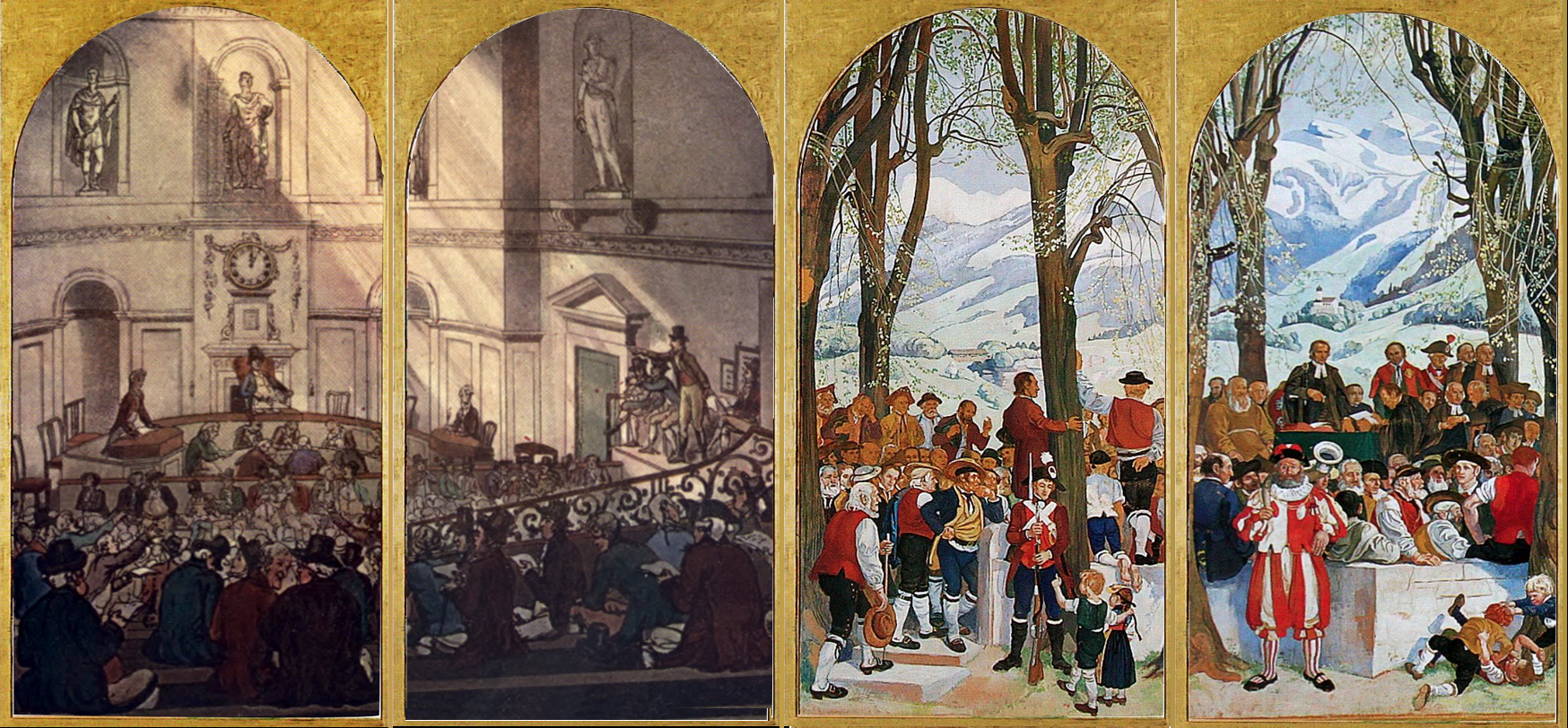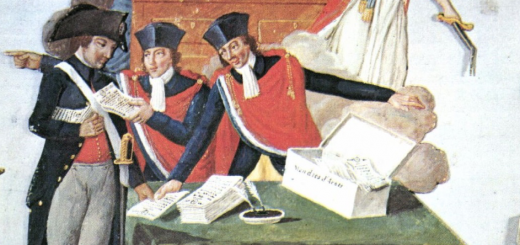Corporate Landsgemeinden: between pure democracy and capitalist plutocracy

Every year, at the turn of April and May, the people of Glarus and Appenzell Innerrhoden meet in general assemblies of citizens, in order to vote on laws and elect some of their cantonal officers. A few weeks earlier, and just a few hundred kilometers from this symbol of Swiss democracy, the general meeting of Nestlé’s shareholders takes place in Lausanne. To many, these institutions seem diametrically opposed. The former is often referred as an example of ‘pure democracy’; while the latter is perceived as the epitome of capitalist plutocracy. So far so good, but are they really different?
If we put aside the rather medieval ceremonial of Landsgemeinden (standard bearers, court ushers and clerks in historical robes, etc.) or the corporate babble of CEO speeches, they also have many features in common. In fact, the descriptions generally given for these assemblies are almost literally identical.
- A Landsgemeinde is an annual open-air political assembly in which every adult citizen of the canton has the right to take part and to vote. This assembly is sovereign in that it adopts or ratifies laws and elects the members of the Executive council.
- A company’s general meeting is an annual assembly in which every shareholder of the company has the right to attend, speak and vote. Sovereignty is vested in the assembly, in that it elects the members of the board of directors, it can ratify and adopt by-laws, and even change its statutes or vote the dissolution of the corporation.
There are, however, some differences. In most major companies such as Nestlé, shareholders (or their proxies) now vote by remote control, while at Glarus and Appenzell Innerrhoden citizens still vote by a show of hand in their Landsgemeinden.[1] Contrary to citizens’ meeting, in corporations one person can have more than one vote, according to the principle “one share, one vote”. But we should not be too ready to conclude that these differences make of Landsgemeinden and shareholders meetings institutions of a completely distinct nature. Historically, shareholders used to vote by a show of hands in their general meetings, like people still do in Landsgemeinden, while plural voting prevailed in companies across the world only after the 1850’s.[2]
With that in mind, it seems that there is a largely ignored part of the history of what we call ‘direct democracy’: a History which binds intricately together communal constitutional models and corporate governance. In this research note, I would like to give you some elements about this common history of municipal assemblies and shareholder meetings.
Landsgemeinden and the Medieval communal movement
According to the Dictionnaire historique de la Suisse, Landsgemeinden stemmed from the assembly of citizens that accompanied the bailiff’s criminal courts in some communities. These assemblies were not just judicial gatherings; they were also summoned to elect local public officials and to ratify important decisions concerning the whole community.[3] It is interesting to notice that for many historians the practice of Landsgemeinden actually started during the 13th century, that is to say (and more importantly) at the peak of the Communal Movement in Europe. Between the 11th and 14th centuries, many rural and urban communities throughout Western Christendom were enfranchised. Historians begun to talk about the Communal movement as a widespread phenomenon in order to characterize the emergence of a common model of communal governance during the central Middle-Age, through the spreading of series of similar communal rights, franchises, and political practices. In Susan Reynolds’ words:
“Vocabularies differed, and so did the degree of complexity, but the framework of councils and offices, rotating part-time service, assemblies, elections, and audits was very much the same. Some of the similarities were the result of conscious copying. The consuls of southern France and Germany, like the mayors of England, show that as do the many charters which granted one town the customs of another.”[4]
In other words, a Landammann is the Helvetic version of a mayor or a burgomaster, and Landsgemeinden are nothing but one example of the general councils of citizens you can find in many places in Europe at that time.
In fact, Switzerland was right in the middle of the dissemination area of what specialists call the ‘consular’ communal model.[5] Instead of a model, it is more precise to talk about a family of communal constitutions, with various versions of communal franchises “in the style of” Milan, Nîmes, Soest, etc. In Switzerland, for instance, Neuchâtel’s communal charter was based upon that of Besançon[6], and Freiburg im Breisgau’s communal rights spread to numerous Swiss communities, for example to Bern[7]. In that regard, it would in fact be peculiar to talk about Landsgemeinden as something specifically Swiss. Yes, the political vocabulary is Helvetic, as are some specific practices, but the big picture reflects European communalism.[8]
While communes were developing, so did corporations. Their evolution was closely intertwined, as they were adapted from the same notions in medieval Roman law of universitas and collegium. Many communities used the same terms of universitas or collegium in their charters and franchises to characterize the nature of their common association as legal persons provided with their own rights and liabilities. Whether it was a municipality, a trading guild or corporations of lawyers or scholars (the future universities), once incorporated (viz. acknowledged by public authorities), they were all political bodies roughly organized in similar ways. As the Digest puts it (Digest 3.4.1), once a community was recognized as a licit association, it might “after the example of the public body (rei publicae) have common goods, a common chest”, and have “a representative to conduct common business”.[9] Common good, common chest, common business, the temptation is strong to draw certain conclusions about the communal and corporative origins of joint-stock companies.
Common chest and joint-stock
It is, however, quite difficult to determine which particular features of today’s corporate governance come from municipal governance, and which ones derive instead from medieval guilds.[10] For instance, according to Franklin Gevutz, companies’ boards of directors originate at the same time from parliamentary assemblies, town councils, guilds and church councils.[11] We can probably extend Gevutz’s conclusions to most practices of corporate governance, since the idea of corporation is at the confluence of various similar political experiences stretching from the 11th century to the end of the Ancien Régime.
The names of important communal places or titles in various communities provide many instances of the close connections between economic corporations (also called guilds and hanses) and municipalities. For instance, the title of “comte de la hanse” for the treasurers in Lille or the Hansgraaf in Audenarde are examples of collusions between the local guilds and the communal government. In other towns like Bruges and Tournai, we know that the contributions of the members of the local merchant guilds supported directly the communal finances.[12] There are many cases showing the direct involvement of economic corporations in the administration of major cities. Just to name a few we might recall the “Hanse des marchands de l’eau” in Paris, the livery companies in London, the Zünfte in Basel or the arti maggiori e minori in Renaissance Florence.
Amongst the most fascinating examples of collusion between corporate and municipal governance, one is particularly intriguing: the Bank of Saint George (Casa di San Giorgio) in Genoa. During the 16th century, the Bank of Saint George became central in the Republic’s political affairs. The Bank administered directly Genoa’s Caspian Sea colonies and the islands of Corsica and Chios; it also collected most of the Republic’s taxes. Basically, until the end of the 18th century, people associated the “good polity” of Genoa to the governance practices of its Bank. For thinkers like Machiavelli, Montesquieu and Hume, the Bank was nothing less than a model of virtuous, wise, honest and prosperous mixed government.[13] This financial institution, however, did not emerge out of nowhere, and its governance adopted many political practices of its republic, like its communal structure in the great and small councils, and its very complex system of elections and political quotas. What is fascinating about the Casa di San Giorgio is that it is one of the few companies that have given shape to modern corporate governance. According to Carlo Taviani, for instance, the organization of the Bank was imitated and adapted by many other major corporations, like the Dutch and English East India Companies, the Bank of England or the (in)famous Mississippi Company of John Law.[14] Those corporations were also directly involved in their respective States’ political affairs: ruling over distant territories and people, collecting taxes and so on.
All considered, for many lawyers until the 18th century, economic corporations and municipalities were institutions of the same kind. It is significant that, in his Treatise on the Law of Corporations of 1793 the English lawyer Steward Kyd should observe that “corporations were also called franchises” (franchise meaning at the time a grant of liberty, privileges, immunities, etc.); or the fact that William Blackstone in 1757 defined corporations as “little republics” whose by-laws were a type of municipal laws.[15] In France in the same period, the Encyclopedie explained that “corporation” was an English legal term to describe what French lawyers called “community”, a term which encompassed guilds, companies, municipalities, universities, colleges, or even bishoprics.[16] Let’s stop here by saying that, in spite of the attempts made during the French Revolution to establish a new political system free from Ancien Régime’s corporations, European institutional history remained deeply corporative. What other factor could explain the fact that we maintain, in the most common of our associations, the same basic structure as Ancien Régime corporations: annual general meetings, executive councils and three distinct associative officers (secretary, president and treasurer)? Amongst the hundreds of ways in which we might have shaped our associations, we did in fact keep this specific one.
Landsgemeinden’s plutocratic equivalents
What shall we conclude from all of this? If you go to Wikipedia and enter “Direct Democracy” the first picture you get is one of a Glarus Landsgemeinde. Then, the article exemplifies the notion with Athenian Democracy, Swiss referendums, New England town meetings, and even the Crow Nation’s General Council in Montana. However, not a word is said about corporate governance, despite the fact that Landsgemeinden have striking similitudes with shareholders general meetings, and that they share a common history with them. Unscientific as this wikipedia example might be, it is quite representative of the recurrent oversight of shareholders’ meetings in democratic studies. While our political vocabulary borrowed many terms from the corporate world (for instance: the “trustee model of representation”), we tend to believe that the history of democracy (and a fortiori of direct democracy) is almost exclusively a matter of political history. If we accept the idea that Landsgemeinden epitomize “direct democracy”, what should we say about shareholder general meetings? As plutocratic as they are, firms’ general meetings are in fact the corporate equivalent of Swiss Landsgemeinden, an equivalent that democratic studies should not overlook.
Henri-Pierre Mottironi(@HP_Mottironi) is teaching assistant at the Institut d’études politiques of the University of Lausanne and a member of the Walras Pareto Centre of interdisciplinary studies in economic and political thought. He is a PhD Candidate in History of political thought and political theory and is currently completing his doctoral dissertation on the influence of corporate governance on French political and constitutional thought from the central Middle-Age to the French Revolution. Amongst others, he published in the Revue française d’Histoire des idées politiques an article on Thomas Paine and property-owning democracy in 2017, and another paper on the idea of fiduciary trust in early 18th-century British political thought is forthcoming.
Footnotes
- In 2016, Glarus rejected the idea of introducing remote control devices in its Landsgemeinde. Geiser Urs, Bondolfi Sibilla, “Glarus: no e-vote counting at open-air assembly”, 7th of September 2016, Swissinfo.ch, https://www.swissinfo.ch/eng/glarus_no-e-vote-counting-at-open-air-assembly/42427778, last consultation 18th of May 2020. ↩
- Dunlavy Colleeen A., “From Citizens to Plutocrats: Nineteenth-Century Shareholder voting Rights and Theories of the Corporation”, in Kenneth Lipartito and David B. Sicilia (eds), Constructing Corporate America: History, Politics, Culture, Oxford, Oxford University Press, 2004, pp. 66‑93. ↩
- Stadler Hans, “Landsgemeinde”, in Dictionnaire historique de la Suisse, 2009, http://www.hls-dhs-dss.ch/textes/f/F10239.php, last consultation 8th of May 2020. ↩
- Reynolds Susan, Kingdoms and communities in Western Europe, 900-1300, Oxford, Oxford University Press, 1997, pp. 196-7. ↩
- Gouron André, “Diffusion des consulats méridionaux et expansion du droit romain aux XIIe et XIIIe siècles”, Bibliothèque de l’École des chartes, 1963, tome 121, pp. 26‑76. ↩
- Jelmini Jean-Pierre, Egloff Michel, “Neuchâtel (Commune)”, in Dictionnaire historique de la Suisse, 2017, https://hls-dhs-dss.ch/fr/articles/002853/2017-02-20/, last consultation 8th of May 2020. ↩
- Zahnd Urs Martin, Martin Pierre G., “Berne (commune)”, chap 2.5: “Constitution communale”, in Dictionnaire historique de la Suisse, Laurent Auberson (trad.), 2016, https://hls-dhs-dss.ch/fr/articles/000209/2016-11-10/, last consultation 8th of May 2020. ↩
- It is what the historian Peter Blickle supports. Blickle Peter, “Communalism, parliamentarism, republicanism”, Parliaments, Estates and Represnetation, June 1986, vol. 6, no 1, pp. 1‑13. ↩
- Black Antony, Guild & State: European Political Thought from the Twelfth Century to the Present, New Brunswick, N.J, Transaction Publishers, 2003, p. 19. ↩
- See for example: Scott William Robert, The Constitution and Finance of English, Scottish and Irish Joint-Stock Companies to 1720, Cambridge MA, Cambridge University Press, 1912, vol. 1, pp. 4-8. ↩
- Gevutz Franklin A., “The Historical and Political Origins of the Corporate Board of Directors”, Hosfra Law Review, mai 2004, vol. 33, no 1, pp. 89‑174. ↩
- Pirenne Henri, Les villes du Moyen-Age, essai d’histoire économique et sociale, Bruxelles, Lamertin, 1927, pp. 164-5. ↩
- Machiavel Nicolas, Histoires florentines, Livre VIII, chapitre XXIX, in Machiavel Œuvres Complètes, Paris, Gallimard, nrf, p. 1384; Hume David, “That politics may be reduce to a science”, in Political essays, Knud Haakonssen (ed.) Cambridge, Cambridge University Press, Cambridge Texts in the History of Political Thought, 1994, p. 11; Montesquieu Charles de Secondat de, De l’esprit des lois, Paris, Flammarion, n˚ 325, 2005, tome I, Livre II, chapitre III, pp. 136-7. ↩
- Taviani Carlo, “An Ancient Scheme: The Mississippi Company, Machiavelli, and the Casa di San Giorgio (1407–1720)”, in Emily Erikson (dir.), Chartering Capitalism: Organizing Markets, States, and Publics, Bingley, Emerald, Political Power and Social Theory, n˚ 29, 2015, pp. 239‑56. ↩
- Kyd Steward, A Treatise on the Law of Corporations, Printed or J. Butterworth, Fleet-Street, 1793, vol. 1, p. 14; Blackstone Sir William, Commentaries on the Laws of England in Four Books, Philadelphia, J. B. Lippincott, 1893, vol. 1, p. 468. ↩
- Diderot Denis et Le Rond d’Alembert Jean, Encyclopédie, ou Dictionnaire raisonné des sciences, des arts et des métiers, Neuchâtel, Chez Samuel Faulche & compagnie, libraires & imprimeurs, 1751, no T 4, article “corporation”. ↩
To cite this blog post : Henri-Pierre Mottironi, « Corporate Landsgemeinden: Between Pure Democracy and Capitalist Plutocracy », Blog of the Centre Walras Pareto, June 4, 2020, https://wp.unil.ch/cwp-blog/2020/06/corporate-landsgemeinden.



